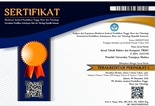Design and Build a Legal Service Information System Using the Personal Extreme Programming Method at the Legal Service Center of the Kalimantan Institute of Technology
Abstract
Each institution has services that play an important role in supporting smooth operations, just as the Kalimantan Institute of Technology (ITK) has legal services through the Legal Service Center (PLH). PLH is tasked with providing administrative support and legal information to the academic community. However, in its implementation, PLH faces various obstacles such as existential challenges related to clarity of roles, duties, services, and functions, as well as a lack of transparency, especially in the process of making the Rector's Decree. In addition, the lack of an integrated system causes service data management to be scattered, causing inefficiencies in data management and business processes that run on each service. To overcome these problems, a website-based Legal Service Information System was developed using the Personal Extreme Programming (PXP) method with stages of system needs analysis, planning, iteration initiation, design, implementation, system testing, and retrospective. This system was developed using the Laravel framework with features such as checking the status of decision letters, reviewing memoranda of understanding and agreements, reviewing rector regulations, and legal consultation. The system was completed by the developers with 6 iterations and 41 user stories. There are 4 main actors: the head of PLH, PLH staff, rectorate staff, and users. The test was carried out using the black box testing method in each iteration with the Legal Service Center of the Kalimantan Institute of Technology, and the results were in accordance and successfully carried out.
Keywords
Full Text:
PDFReferences
Menteri Pendidikan dan Kebudayaan Republik Indonesia, Peraturan Menteri Pendidikan dan Kebudayaan Republik Indonesia Nomor 139 Tahun 2014 tentang Pedoman Statuta dan Organisasi Perguruan Tinggi. Jakarta: Kementerian Pendidikan dan Kebudayaan, 2014.
T. Pricillia, "Perbandingan Metode Pengembangan Perangkat Lunak (Waterfall, Prototype, RAD)," Jurnal Bangkit Indonesia, vol. 10, no. 1, pp. 6–12, 2021
F. A. Melati, R. W. Pradana, dan N. A. Novi Arisa, "Pengembangan Buku Tamu Digital Pada PT XYZ Menggunakan Metode Personal Extreme Programming," J. Sist. Informasi Dan Teknologi, vol. 5, pp. 73–81, 2024.
Y. Dzhurov, I. Krasteva, dan S. Ilieva, "Personal Extreme Programming–An Agile Process for Autonomous Developers," dalam Proc. Int. Conf. Software, Services & Semantic Technologies, Aug. 2016, pp. 252–259.
D. Abongko, A. Lumenta, dan O. A. Lantang, "Rancang Bangun Sistem Informasi Terpadu Pusat Bantuan Hukum Unsrat," E-Journal Teknik Elektro Dan Komputer, vol. 4, no. 4, pp. 65–70, 2015.
K. Beck, Extreme Programming Explained: Embrace Change, 1st ed. Boston: Addison-Wesley, 1999.
M. F. Riki dan I. Effendy, "Aplikasi Pencarian Donor Darah Menggunakan Metode Personal Extreme Programming Berbasis Android," Smatika Jurnal, vol. 12, no. 02, pp. 186–199, 2022.
DOI: https://doi.org/10.21107/triac.v12i1.29849
Refbacks
- There are currently no refbacks.
Copyright (c) 2025 Jurnal Teknik Elektro dan Komputer TRIAC

This work is licensed under a Creative Commons Attribution-ShareAlike 4.0 International License.

 .
.











